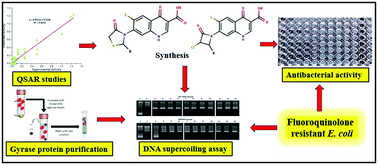The synthesis and biological evaluation of virtually designed fluoroquinolone analogs against fluoroquinolone-resistant Escherichia coli intended for UTI treatment†
Abstract
Fluoroquinolones (FQs) are one of the most commonly prescribed classes of antibiotics for the treatment of urinary tract infections (UTIs), but FQ-resistant Escherichia coli (E. coli) in UTIs is widespread and increasing. In order to address the resistance-related issue, novel drug molecules with the capacity to overcome E. coli resistance are crucial for modern healthcare. Based on this rationale, the virtually screened novel FQ analogs FQ-49, FQ-70, FQ-131, FQ-132, FQ-137, FQ-147, FQ-151, FQ-172, FQ-177, and FQ-182 were synthesized using a microwave-assisted technique. These compounds possessed excellent activity against FQ-resistant E. coli and inhibited purified mutant DNA gyrase activity in vitro. A 3D-QSAR modeling study was used to identify the potent FQ analogs and calculate their molecular properties. Sequence analysis of the quinolone-resistance determining region (QRDR) of purified mutant DNA gyrase enzyme confirmed the presence of Ser83Leu and Asp87Asn mutations in FQ-resistant E. coli isolates from UTI patients. Overall, this study confirmed that ten of the synthesized novel FQ analogs exhibited extremely potent antibacterial activity against existing FQ-resistant E. coli, and they could be further successfully utilized for the treatment of UTIs.



 Please wait while we load your content...
Please wait while we load your content...